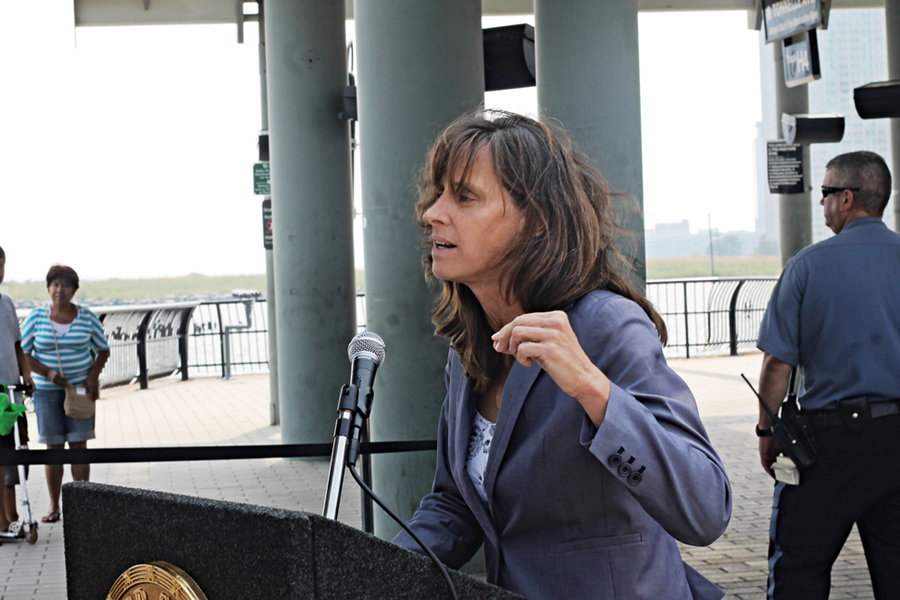“One quarter mile,” County Executive Tom DeGise told Marilyn Shazor, the regional administrator the Federal Transit Administration (and a Secaucus resident), during a countywide tour of the Hudson Bergen Light Rail Line on Wednesday, Sept 2. He explained that if the existing light rail tracks were extended just a quarter of a mile in Jersey City, he said, this could double the property values along the Hackensack River, and open a whole new Gold Coast for development there.
Hoboken Mayor Dawn Zimmer said she was interested in getting an uptown rail station so as to accommodate new development in a former warehouse district along Hoboken’s west side.
“Everyone understands that public transportation is the key to our success in our region and our state,” Zimmer said. “It is a foundation for job growth and a strong economy.”
DeGise, Zimmer, and others joined U.S. Senator Robert Menendez on a 21-mile tour of the HBLR system to show that the Hudson system is a model for the rest of the nation, and could also be expanded.
Originally it was expected to extend into Bergen County, but lack of ability to decide the route had delayed the implementation, said Menendez.
“Everyone understands that public transportation is the key to our success in our region and our state.” – Dawn Zimmer
____________
But the line eventually was extended beyond the original plans, with stops in Union City and extra stops in Bayonne.
Where it stopped
First conceived more than 30 years ago with construction started about 15 years ago, the light rail – funded by federal money – stopped short of achieving its goal to become a two-county system. The line runs from Bayonne through Jersey City, Hoboken, Weehawken, North Bergen, and Union City.
“Since its opening 15 years ago, the Hudson Bergen Light Rail line has become a national model for what transit project can be,” Menendez said. “Light rail is more than just about moving people from one place to another; it’s about investing in our shared economic future … It has been a magnet for community development, attracting thousands of new residents for live in a thriving, walkable environment with access to good transit.”
The next step?
DeGise had met Shazor earlier this year at a function in Atlantic City where he suggested the tour.
“We stopped at every stop to show what progress the light rail has brought to each community,” DeGise said. “I didn’t have to tell her much. She lives in Secaucus. She takes the Light Rail from Tonnelle Avenue to get to work.”
The tour took a look at the North Bergen terminus of the line, and the officials talked about the 10-mile expansion that could take it to Englewood if the money could be found.
Menendez said there a federal program funding transportation projects around the country, but New Jersey failed to even apply.
The federal government funds the Federal New Starts program at about $2 billion. But the state must apply for the program and provide matching dollars. This match would have to come out of the state’s Transportation Trust Fund, which has yet to be fully funded.
The trust fund, which the state legislature must replenish, has about $1.2 billion currently, and he hopes that by adding more, the state can leverage enough to begin construction the next phase. He said he hopes to put in $1.6 billion, maybe even $2 billion.
New Gold Coast?
DeGise believes that the easiest project to complete first would be the extension from West Side Avenue in Jersey City to Route 440 near the Hackensack River.
A development under construction there could expand from about 4,000 units on a 96 acre superfund site to 8,200 if the extension is done.
This is a joint project between the city of Jersey City which owns about 50 acres, and Honeywell Corporation which was responsible for the cleanup of chromium there.
DeGise said negotiations with the developer would help pay for the construction of a new station at the Route 440 site. The estimated cost for the extension would be about $214 million.
DeGise said Menendez and Rep. Albio Sires have done a lot to get federal money in place, but the gap is in state funding.
“Even the developers should kick in some of the money,” he said. “This benefits them. It is a reason why buildings are being built and some areas of Hudson County, and it creates jobs.”
Al Sullivan may be reached at asullivan@hudsonreporter.com.
